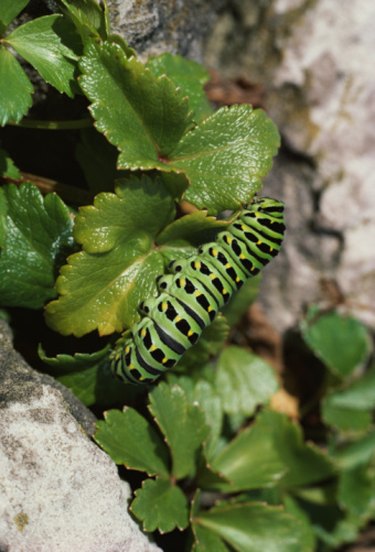
Many gardeners love the idea of creating safe havens for butterflies. These little winged insects can turn gardens into wonderful sites. Caterpillars, immature butterflies and moths will need somewhere to live in these gardens. Providing food and shelter for both the butterflies and caterpillars will attract them to any garden, but if the gardener does not want the caterpillars there, some steps can be taken to prevent and control them.
The Cycle
Video of the Day
Adult butterflies and moths do not eat the foliage of plants. Caterpillars do eat the foliage, sometimes causing harmful amounts of damage. Once the caterpillar hatches from its egg, it will live on and eat the foliage of the tree it was placed on. The caterpillar will gorge itself, and then it will go into the cocoon phase of its life. In this phase the caterpillar transforms into adult form. When it emerges from the cocoon, it will have wings, and the females will go on to lay their eggs on the same types of plants and trees they hatched on.
Video of the Day
Caterpillar Host Plants
Many varieties of caterpillars have preferred plants and trees that they like to live and feed on. Most butterflies will search out very specific trees and plants for their young to live on, but most moths appear far less picky. Tiger swallowtail caterpillars can be found on cherry, birch, tulip trees and ash trees. Viceroy caterpillars often live on willow, poplar and apple trees. Cecropia moth caterpillars will live on many trees. Caterpillars of the Luna moth will also live and feed on many different forest and shade trees.
Caterpillar Control
Some caterpillars tend to become pests in large numbers and can harm or kill the plants and trees they live and feed on. Some type of control method should be used to protect against damage. The Kemper Center for Home Gardening says that the best method for small infestations includes removing the caterpillars one by one. No harmful chemicals will be used for this method. Gardeners pick the caterpillar from its host plant and then kill them by either squashing or dropping them into soapy water. Some predator insects, like fireflies, stink flies and machined flies, will kill some types of caterpillars, helping keep their numbers low. For large infestations, pesticides can be used. When using a pesticide, ensure that it will kill the type of caterpillars infesting the area.
Attracting Caterpillars
Attracting caterpillars to the garden means attracting adult butterflies. Planting trees and plants that caterpillars live on will help attract adult female butterflies, but gardeners will also need to plant nectar plants for the adults to feed from. Honeysuckle, butterfly bush and milkweed will attract butterflies, and they will in turn lay eggs on the host plants, which will help ensure another generation of butterflies in the garden.